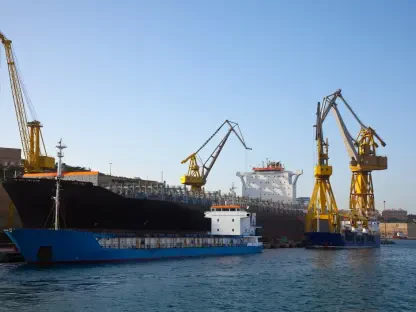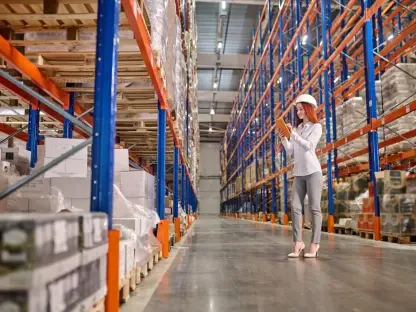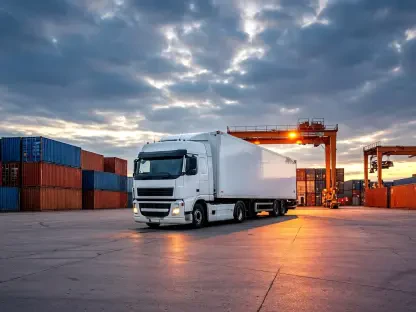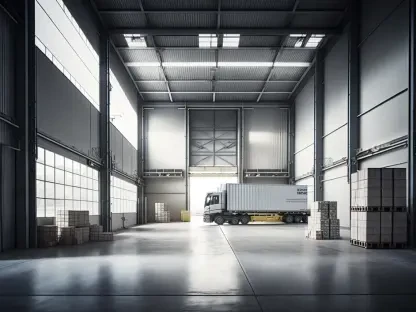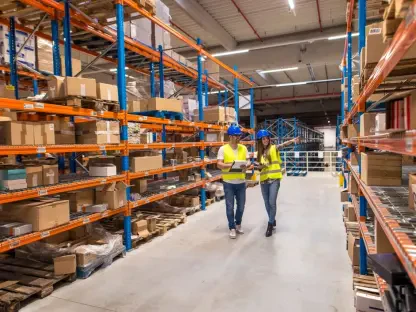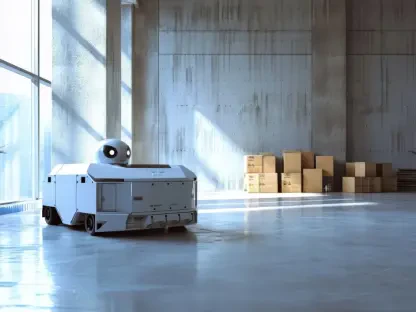This guide aims to provide industrial professionals with a comprehensive understanding of how projected signage can significantly enhance crane safety in high-risk environments by addressing persistent challenges with traditional safety markings. By exploring a cutting-edge solution, this resource offers actionable steps to implement a dynamic and durable safety system, equipping readers with the knowledge to reduce workplace accidents, ensure compliance with regulations, and foster a safer working environment around cranes through innovative technology.
The importance of crane safety cannot be overstated, as industrial settings often face the daunting statistic that crane-related accidents account for a significant percentage of workplace injuries each year. Imagine a bustling construction site where a massive crane swings heavy loads overhead, yet faded floor markings fail to warn workers of danger zones, leading to near misses or worse. This scenario underscores the critical need for reliable safety solutions that maintain visibility and awareness, prompting a deeper look into how projected signage offers a transformative approach to mitigate these risks.
Beyond the immediate hazards, the challenge of maintaining effective safety communication in dynamic environments has long plagued industrial operations. Traditional signage often degrades under harsh conditions, becoming invisible or ignored over time, a problem that heightens the risk for workers navigating around cranes. This guide introduces a partnership between Ireland’s leading crane safety company and a UK-based expert in projected signage, unveiling a solution that promises to redefine safety standards with adaptability and resilience at its core.
Unveiling a Game-Changer in Crane Safety
Crane operations in industrial workplaces present unique safety challenges, where the constant movement of heavy machinery demands clear and consistent warnings to protect workers. The persistent issue of degrading floor signs often results in diminished effectiveness, as workers may overlook critical alerts due to wear or familiarity, a condition commonly referred to as “sign blindness.” This gap in safety communication has historically contributed to accidents, highlighting the urgent need for a more robust solution.
Addressing this concern, a pioneering collaboration between a prominent crane safety firm from Ireland and a UK specialist in projected signage has introduced an innovative tool to transform safety practices. This partnership focuses on leveraging advanced technology to project vivid safety messages directly onto work surfaces, ensuring that warnings remain visible and relevant regardless of environmental conditions. The approach marks a significant departure from static signage, offering a proactive way to maintain worker awareness.
The benefits of this projected signage system are multifaceted, encompassing dynamic visibility that adapts to crane movements, exceptional durability against wear and tear, and the flexibility to update warnings as needed. These advantages collectively combat the shortcomings of traditional methods, providing a snapshot of how industrial safety can evolve through technology. By prioritizing clear communication, this solution sets a new benchmark for protecting workers in high-risk crane environments.
The Persistent Challenge of Traditional Crane Safety Markings
Traditional safety markings in industrial settings have long struggled to keep pace with the demands of crane operations, where constant activity and harsh conditions erode painted floor signs over time. These conventional methods often fade or become obscured by dirt and debris, reducing their visibility and leaving workers vulnerable to hazards. The inability to maintain clear warnings in such environments poses a direct threat to safety, as critical messages fail to reach those who need them most.
Beyond physical degradation, the static nature of traditional signage lacks the adaptability required to address the dynamic risks associated with cranes, such as swinging loads or sudden equipment malfunctions. Workers may grow accustomed to unchanging signs, further diminishing their impact and increasing the likelihood of oversight during critical moments. This lack of responsiveness underscores a fundamental flaw in relying solely on fixed markings for safety in ever-changing work zones.
The specific dangers of crane operations amplify the need for a more effective solution, as moving machinery can create unpredictable hazards that static signs cannot adequately cover. From unexpected shifts in load positioning to environmental factors like wind, the risks are both varied and severe, often resulting in serious injuries if warnings are missed. These challenges collectively highlight the pressing demand for an innovative safety mechanism that can keep up with the complexities of industrial crane environments.
Breaking Down the Projected Signage Solution
Projected signage offers a revolutionary approach to crane safety by utilizing advanced technology to deliver clear, adaptable warnings in real-time. Developed through a strategic collaboration between experts in crane safety and projection systems, this solution addresses the core limitations of traditional markings with a multi-step implementation process. The following sections detail how this technology is applied to enhance safety around cranes, providing a practical framework for industrial applications.
This system fundamentally changes how safety messages are communicated by projecting bright, dynamic alerts directly onto work surfaces, ensuring they remain visible under various conditions. Unlike static signs, these projections can move with the crane, maintaining relevance and urgency as hazards shift. Each step of the process is designed to prioritize worker protection, offering a seamless integration of technology into everyday safety protocols.
Step 1: Mounting High-Powered LED Projectors on Cranes
The first step in implementing projected signage involves installing high-powered LED gobo projectors directly onto the crane’s arm, a strategic placement that maximizes coverage. These devices are engineered to project bright, vivid safety messages onto any surface below, ensuring that warnings are visible regardless of the crane’s position on the site. This setup eliminates the dependency on ground-based markings, providing a consistent safety presence from above.
Ensuring Visibility Across Diverse Surfaces
A key advantage of these projectors lies in their ability to adapt to diverse site conditions, projecting clear warnings even on uneven or cluttered floors. Whether the surface is concrete, gravel, or obstructed by equipment, the projected messages maintain their clarity and impact, reaching workers effectively. This adaptability ensures that safety alerts are not compromised by environmental challenges, delivering maximum visibility in all scenarios.
Step 2: Creating Dynamic Safety Warnings
The second step focuses on the dynamic nature of projected signage, which moves in sync with the crane to display critical messages such as “Keep Clear” or hatched floor signs in real-time. This mobility ensures that danger zones are continuously marked as the crane operates, providing immediate updates to workers about hazardous areas. Such responsiveness is a significant improvement over static signage, which cannot adjust to changing conditions.
Maintaining Constant Awareness with Moving Signs
Dynamic warnings play a crucial role in preventing desensitization among workers, as the moving projections capture attention and reinforce the presence of risks. Unlike fixed signs that may blend into the background over time, these mobile alerts follow the crane’s path, keeping safety at the forefront of awareness. This constant reminder helps maintain vigilance, reducing the likelihood of accidents due to oversight.
Step 3: Defining the Safe Operating Zone (SOZ)
The third step involves projecting a Safe Operating Zone, a designated safety area that encompasses the crane’s full reach along with an additional buffer to account for potential hazards. This zone acts as a visual boundary, clearly marking the limits of safe operation to protect against risks like swinging loads or sudden weather changes. Defining this area through projection ensures it remains visible and relevant throughout the crane’s activity.
Protecting Workers with a Clear Safety Buffer
The Safe Operating Zone serves as a vital barrier, keeping unauthorized personnel at a safe distance and ensuring adherence to lifting equipment regulations. By visibly delineating this buffer, the projection system helps prevent accidental intrusions into high-risk areas, safeguarding workers from preventable dangers. This clear demarcation enhances overall site safety, providing a reliable guide for maintaining secure operations.
Key Takeaways from Projected Signage Innovation
The adoption of projected signage brings several critical advantages to crane safety, summarized in the following points for clarity and impact:
- Enhanced visibility through bright, dynamic projections that adapt seamlessly to crane movements.
- Increased durability over traditional floor markings, significantly reducing the need for frequent maintenance.
- Improved worker awareness by combating “sign blindness” with mobile, attention-grabbing safety warnings.
- Compliance with safety standards through the clear definition of Safe Operating Zones around cranes.
- A scalable solution that can be applied across various industrial settings where cranes are in operation.
The Broader Impact on Industrial Safety Trends
Projected signage represents a pivotal shift in industrial safety, aligning with a growing trend toward technology-driven solutions that prioritize worker protection. This innovation moves away from static, easily degraded markings, embracing adaptable systems that can withstand the rigors of industrial environments. The integration of projection technology reflects an industry-wide commitment to leveraging modern tools for enhanced safety outcomes.
Looking ahead, the potential for further advancements in this space is significant, with possibilities for integrating projected signage with other smart safety systems like sensors or automated alerts. Such developments could create a more interconnected safety network, offering real-time data to further mitigate risks. However, challenges such as initial adoption costs and the need for specialized training must be considered to ensure widespread implementation.
The broader implications of this trend extend beyond cranes, suggesting a future where dynamic safety solutions become standard across various industrial applications. As companies recognize the value of resilient and flexible systems, the push for innovation in safety protocols is likely to accelerate. This evolution underscores the importance of staying ahead of emerging technologies to protect workers in increasingly complex work environments.
Embracing Innovation for Safer Workplaces
Reflecting on the journey of integrating projected signage into crane safety, the collaboration between leading industry experts has proven to be a transformative step in addressing visibility and compliance challenges. The detailed steps of mounting projectors, creating dynamic warnings, and defining safe zones have collectively established a new standard for protecting workers in high-risk settings. This initiative has demonstrated that technology can effectively bridge the gaps left by traditional methods.
Industrial companies that have embraced this solution found a marked improvement in workplace safety, with fewer incidents attributed to overlooked warnings. The next actionable step for other organizations is to evaluate their current safety systems and consider investing in projected signage to mitigate similar risks. Exploring partnerships with specialized providers offers a practical path to implementation, ensuring tailored solutions for specific operational needs.
As a final consideration, staying informed about advancements in safety technology remains crucial for maintaining a proactive stance against workplace hazards. Companies are encouraged to seek out resources and expertise from innovators in the field to customize projected signage systems for their unique environments. This forward-thinking approach has laid the groundwork for safer industrial operations, protecting workers from preventable dangers through sustained innovation.


